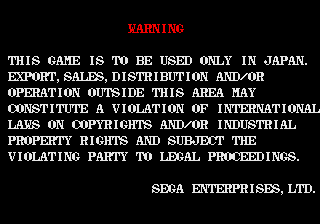If you appreciate the work done within the wiki, please consider supporting The Cutting Room Floor on Patreon. Thanks for all your support!
Puyo Puyo (Arcade)
| Puyo Puyo |
|---|
|
Developer: Compile
|
Unlike the MSX2 and Famicom Disk System games of the same name, the arcade Puyo Puyo focuses exclusively on competitive play, which would prove to be the franchise's ticket to success.
To do:
|
Contents
Regional Differences
The English version (labeled "World" in MAME) was, for years, one of the greatest Puyo Puyo-related mysteries. Much of the information regarding its release has been lost to time, and international fans initially assumed that it was a bootleg. References of any kind to this version in Japan are comparatively scarce, with a single mention on Japanese Wikipedia dubbing it "the Europe version" and a PCB recording by BEEP Akihabara being the only Japanese references to this version online. Its inclusion in the Sega Ages series for the Nintendo Switch confirms that it is an official translation, and a couple of 1990s developer interviews allude to a European version with name changes, but when, how, and precisely where this version released is completely unknown. Regardless, the English version features some aesthetic changes.
Copyright Notice
The Japanese versions display a copyright notice on boot. World doesn't have an equivalent notice, and instead goes straight to the title screen.
Title Screen
World's title logo is slightly different in style. However, it goes through the same stretching animations as the Japanese version.
| Japan | World |
|---|---|
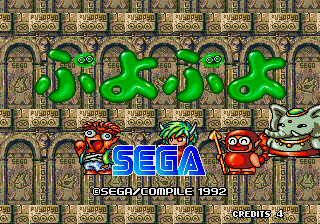 |
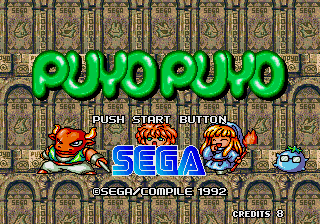 |
Voice Work
The voice work was redone in English for the World version, with Carbuncle's catchphrase being the only voice sample that survives the transition. The World version has fewer samples overall; two samples used in the final sequence (いっきま~す at the start of the character reel and おしまい at the end of it) have no English equivalents, while other samples are used multiple times. For example, the "Puyo Puyo!" from the title screen is also used for a 5+ player chain.
Name Changes
A vast majority of the characters' names are changed. The four-letter abbreviation above each character's preview window is changed accordingly, with the exception of Arle, whose abbreviation becomes "YOU."
| Japan | World |
|---|---|
| Arle Nadja [ARLE] | Silvana [YOU] |
| Skeleton-T [SKEL] | Skeleton [SKEL] |
| Nasu Grave [NASU] | Blue Ghost [GOST] |
| Mummy [MUMY] | Mummy [MUMY] |
| Draco Centauros [DRAC] | Dragon Woman [DRAG] |
| Suketoudara [TARA] | Goby Captain [GOBY] |
| Sukiyapotes [POTE] | Small Foot [FOOT] |
| Harpy [HAPY] | Dark Elf [ELF] |
| Sasoriman [SCOP] | Scorpion Man [SCOP] |
| Panotty [PANO] | Johnny [JONY] |
| Zombie [ZOMB] | Zombie [ZOMB] |
| Witch [WICH] | Witch [WICH] |
| Zoh Daimaoh [ZOH] | Elephant Lord [LORD] |
| Schezo Wegey [SHEZ] | Devious [DEVI] |
| Minotauros [MINO] | Max Minotaur [MINO] |
| Rulue [RULU] | Lulu [LULU] |
| Satan [SATN] | Dark Prince [PRIN] |
| Carbuncle | Carbuncle |
Most of the name changes are exclusive to this version; only Dark Prince would be used in later games.
Harpy / Dark Elf
World removes Harpy's wings and flying animation, and also changes her dress's color from white to a dark shade of green. This is reflected in both her cutscene sprites and her battle portrait.
| Japan | World |
|---|---|
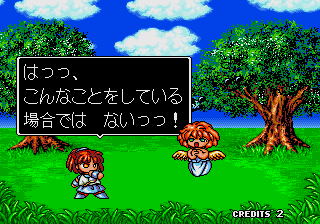 |
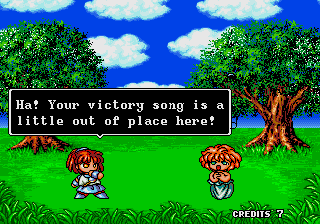 |
| Japan | World |
|---|---|
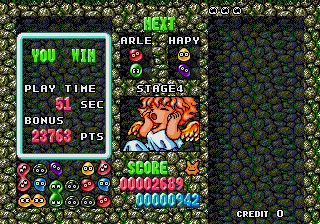 |
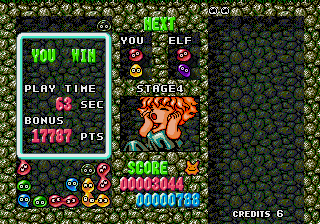 |
Other Graphical Changes
World slightly modifies the cutscene choreography, resulting in two animations (Draco's laughing animation and Satan's initial reaction to Arle calling him "Santa") going completely unused. The animations are still in the game, just never referenced.
Unused "Double" Diacute Voice Sample
| Normal Diacute | Double Diacute |
|---|---|
The Japanese versions contain an alternate, unused version of Arle's "Diacute" spell where she stutters the first syllable. This is a reference to the Madou Monogatari games, where the damage-doubling Diacute causes Arle to stutter the name of her next spell; in this case, it behaves as if she casted Diacute twice.
The following MAME cheat forces the game to play the double Diacute for any and all voice sample calls. Using an index of 05 will instead play the singular Diacute sample that is used in normal gameplay.
<cheat desc="D-D-Diacute Voice Lock"> <comment>The game will play the double Diacute for all voice samples.</comment> <script state="run"> <action>maincpu.pb@e0b0c5=04</action> <action>maincpu.pb@e0b008=04</action> <action>maincpu.pb@e00155=04</action> </script> </cheat>
Sixth Puyo
The MSX2 and Famicom Disk System Puyo Puyo use six Puyo colors, and if this prototype footage is any indication, the Mega Drive version almost did as well. (P1's top Puyo at 5:45 never appears in the final game or any Puyo game.) As it turns out, the sixth Puyo does indeed exist in the arcade version, can be placed on the field with easy modifications to Mamecheat.co.uk's Puyo Puyo cheat files, and (aside from being visually broken) is fully functional.
Mamecheat intentionally skipped over the sixth Puyo for each of their Puyo-setting cheats. For example:
<cheat desc="Select Perm. Next Top Bubble PL1">
<parameter>
<item value="0x00">Red</item>
<item value="0x01">Yellow</item>
<item value="0x03">Green</item>
<item value="0x04">Purple</item>
<item value="0x05">Blue</item>
</parameter>
<script state="run">
<action>maincpu.pb@FFE127=param</action>
</script>
</cheat>
Adding the sixth Puyo as an option is a simple matter of filling in the unused slot.
<cheat desc="Select Perm. Next Top Bubble PL1">
<parameter>
<item value="0x00">Red</item>
<item value="0x01">Yellow</item>
<item value="0x02">Sixth</item>
<item value="0x03">Green</item>
<item value="0x04">Purple</item>
<item value="0x05">Blue</item>
</parameter>
<script state="run">
<action>maincpu.pb@FFE127=param</action>
</script>
</cheat>
There are unrelated parts of the game that are affected by these cheats, so it is recommended to only activate them during battle.
Revision Differences
There are two bugs in the Rev. A (Japanese) version:
- The AI loses its ability to manually drop Puyo if the other joystick is held to the left or right (this effect is easily seen with Harpy who would normally start a match by quickly lining her far left and far right columns).
- When pressing UP on the BEST RECORD board, the player would be able to select from 29 letters instead of 28 letters.
The Rev. B (Japanese) version updated the code to fix the bugs (see table below for the changes). The World (English) version, Mega Drive port, and Dr. Robotnik's Mean Bean Machine were based on Rev. A, so the bugs were not fixed.
The SEGA AGES Puyo Puyo on Switch however does not have these bugs. These were fixed when porting the Rev. B and World versions.
| Rev. A | Rev. B |
|---|---|
| E9CC = andi.w #$FD8F, D0 E9D0 = andi.b #$F3, D1 A1B0 = move.b #$1C, ($12, A0, d0.w) |
E9CC = andi.w #0, D0 E9D0 = andi.b #0, D1 A1B0 = move.b #$1B, ($12, A0, d0.w) |
References
- Pages missing developer references
- Games developed by Compile
- Pages missing publisher references
- Games published by Sega
- Arcade games
- Pages missing date references
- Games released in 1992
- Games released in October
- Games with unused sounds
- Games with regional differences
- Games with revisional differences
- To do
- Puyo Puyo series
Cleanup > Pages missing date references
Cleanup > Pages missing developer references
Cleanup > Pages missing publisher references
Cleanup > To do
Games > Games by content > Games with regional differences
Games > Games by content > Games with revisional differences
Games > Games by content > Games with unused sounds
Games > Games by developer > Games developed by Compile
Games > Games by platform > Arcade games
Games > Games by publisher > Games published by Sega
Games > Games by release date > Games released in 1992
Games > Games by release date > Games released in October
Games > Games by series > Puyo Puyo series
